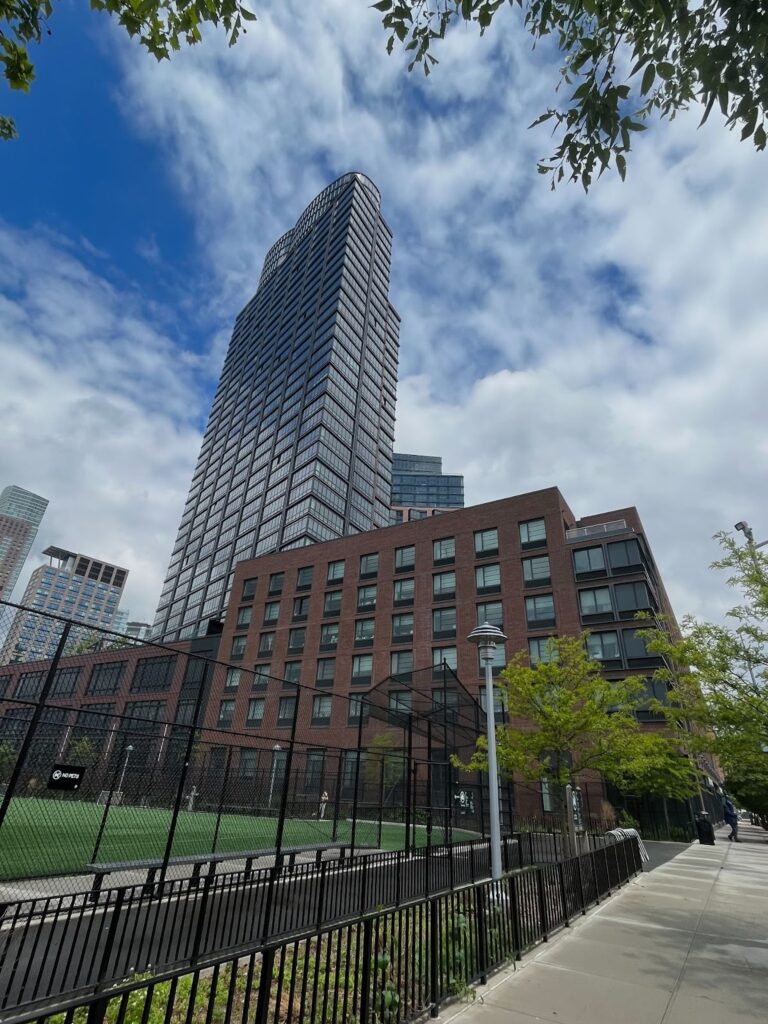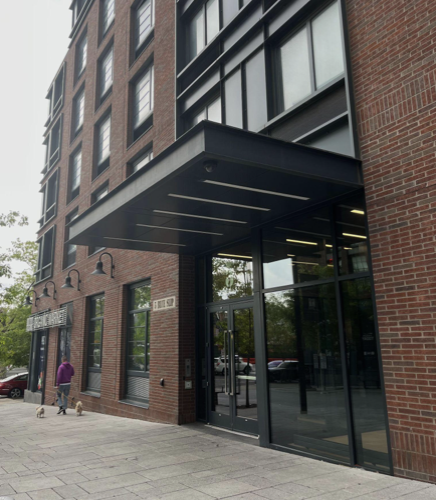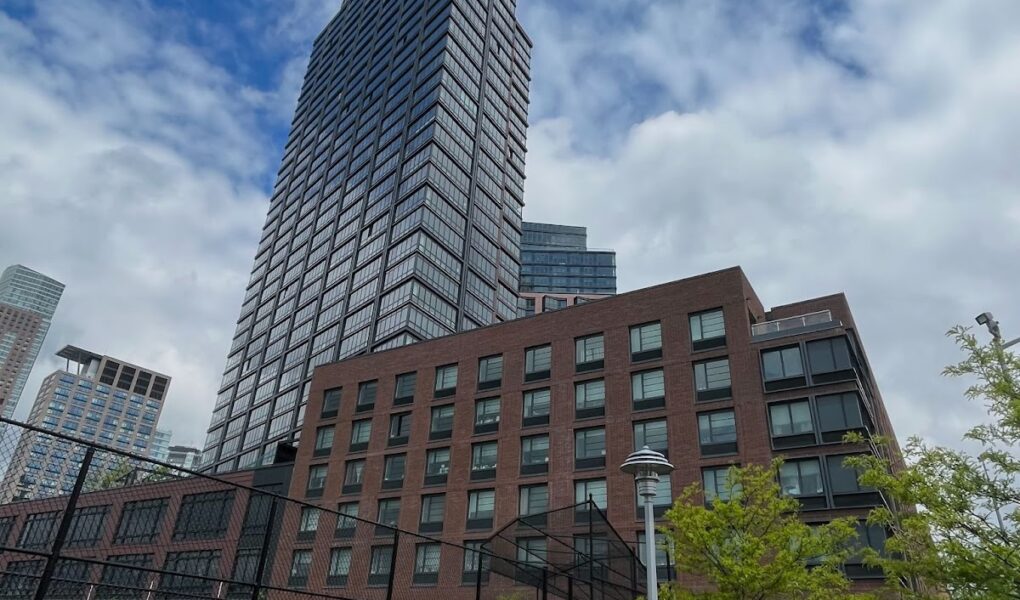Located at the cusp of the East River, the Greenpoint Landing Esplanade overlooks some of Manhattan’s greatest landmarks. When standing amongst the waterfront greenery, your back facing the river this time, you’ll find yourself looking at two tall luxury towers whose private garages open and close revealing seas of glamorous vehicles that rest inside. Somewhere behind the newly constructed buildings, however, hides a smaller, somewhat less glamorous one – the affordable housing attachment.
Park Tower Group, in a joint venture with Brookfield Properties and two other major development companies, first debuted Greenpoint Landing in 2018 when its first tower, located at 1 Blue Slip, opened its 359 market rate units to New Yorkers seeking luxury rentals. This is the first out of 10 buildings that are to be built as a part of the development made possible by the 421-a. There are currently three buildings built as parts of Greenpoint Landing dedicated wholly to affordable housing. Constructed as attachments to the luxury towers, the three buildings total 294 affordable units only available to the public through a housing lottery.
The 421-a, established in 1971, was intended to incentivize the utilization of underdeveloped areas by providing significant property tax reduction to real estate developers, in turn for the inclusion of a certain number of affordable units amongst market rate housing. It seemed to be a way of revitalizing neighborhoods such as Greenpoint, that used to be primarily industrial, by developing inclusionary housing projects.
Greenpoint Landing’s approach to affordable housing then becomes somewhat reminiscent of the infamous ‘poor door’ developers used to include in their mixed income projects once upon a time. Extell Development’s 2013 project, best known as One Riverside Park, is commonly referred to as the development that started the practice of separating tenants according to income. While its market rate tenants enjoyed a luxurious entrance facing the Hudson, the other side of the building had a smaller, much less noticeable entrance for those paying affordable rates. This practice consequently coined the term ‘poor door’ in an article by the West Side Rag in which they used it to describe the situation in One Riverside Park.

What seems to be the approach taken by Greenpoint and a few other developers in more recent times is a shift in construction from building ‘poor doors’ to building separate ‘poor buildings’. Apart from being in a separate building, the affordable housing tenants in many cases lack access to amenities. “My opinion is that the integration of affordable housing into luxury buildings is tough”, said Matthew Kwatinetz, a professor at NYU Schack’s Institute of Real Estate, “developers can make arguments about why those paying higher prices should receive higher services, but I think those arguments are mostly false”. Professor Kwatinetz further said “this is because the developer would not be able to build those luxury residences without the public sector paying the tax benefit or zoning benefit. So, in essence, those in the affordable units have also paid and should receive the same benefits”. Brookfield Properties declined to comment.
Not all of academia agrees with this viewpoint however, as Barry Hersh, NYU Clinical Professor of Real Estate and Developer, who spent some time at the site of Greenpoint Landing during construction himself, deems affordable housing tenants “lucky”. “Lottery is really an important word,” Professor Hersh said, “I think the people who got those affordable units view themselves as lucky, and they are”.
Many agree with this point of view as the construction of ‘poor buildings’ technically doesn’t break any laws. In 2015, former Mayor Bill de Blasio introduced a renewed Rent Regulation bill that essentially outlawed ‘poor doors’ yet it said nothing about ‘poor buildings’. “Instead of calling lottery winners lucky, I think we should consider it our obligation to create quality housing for all,” said Bill de Blasio, in an interview. “However, if building separate buildings for affordable housing in certain cases will increase the number of units for working and low income people then it serves a greater good.”
Some are calling it bypassing, and others claim it’s a loophole, however technically by building the affordable housing in a separate building, zoning laws require a separate entrance. “While activists might not like this, it is not technically a ‘poor door’,” said Professor Kawanetz.
Ada is a resident at 5 Blue Slip, who moved into her affordable unit after two years on the waitlist of the Greenpoint Housing Connect Lottery. “We feel comfortable here,” Ada says about her building and neighborhood. “The size of the apartment and the looks are very nice.” Besides complaints about the inconvenient location to the subway, Ada and her housemate enjoy Greenpoint Landing. “Nobody messes with us here, everyone does their own thing,” Ada says about her neighbors.

While some tenants may consider themselves fortunate, there has been a fair amount of outcry for inclusionary housing when it comes to Greenpoint and its’ ‘poor buildings’. In an interview with the Brooklyn Paper, Helen Kersten, a vocal opponent of Greenpoint Landing, said people “would know [which tenants] are poor because of the door they go into,” deeming the construction exclusionary. Furthermore, affordable and inclusionary housing advocates all over the city and the country are working on the representation of tenants in similar situations. “There are trade-offs,” said Lisa Sturtevant, vice president for research at the National Housing Conference in Washington, in an interview with the New York Times. “It’s really important that there’s no discrimination, but there’s a balance between what we can do and should do.”
Although it has led to some ironically exclusionary development practices, under mandatory inclusionary laws, the 421-a successfully incentivized many developers to build affordable housing. “Developers will in most cases either build luxury, or build affordable,” said Professor Hersh, “the idea of building middle class housing is impossible.” The 421-a has therefore bridged the gap between these two sides of the spectrum and encouraged an increase in the number of affordable units as well as mixed income developments in New York City.
The cessation of the 421-a in 2022 has left everyone wondering about the future of affordable housing in the city. “There was no agreement on how to adapt the bill and so it lapsed, putting a lot of affordable housing on hold,” said Bill de Blasio. “While it had outlived its usefulness, we saw the real value in 421-a, particularly in the combination with mandatory inclusionary housing laws, in maximizing the number of affordable units for working people and low income people.” Others, like Professor Matthew Kawanetz, worry the discontinuation of the 421-a will have reduced “not only affordable housing but also market rate housing in all but the most luxury neighborhoods”. Professor Kawanetz explains “this is because most market rate development does not pencil without a tax break — it was designed that way to increase leverage for creating affordability in most areas”.
The absence of the 421-a bill will then have an impact on the city’s 10-year affordable housing plan that promised 80,000 new and 120,000 renewed affordable housing units by 2024. Under threat of incompletion, it perhaps becomes more important to focus on maximizing construction of affordable units which developments like Greenpoint are doing. “In my opinion, the goal should be to maximize the number of affordable units, while focusing on maximizing mixed-income properties at the same time,” said Bill de Blasio. “The sad reality, however, is that none of this is getting us where we need to be to complete our goal,” and we need to do better.




